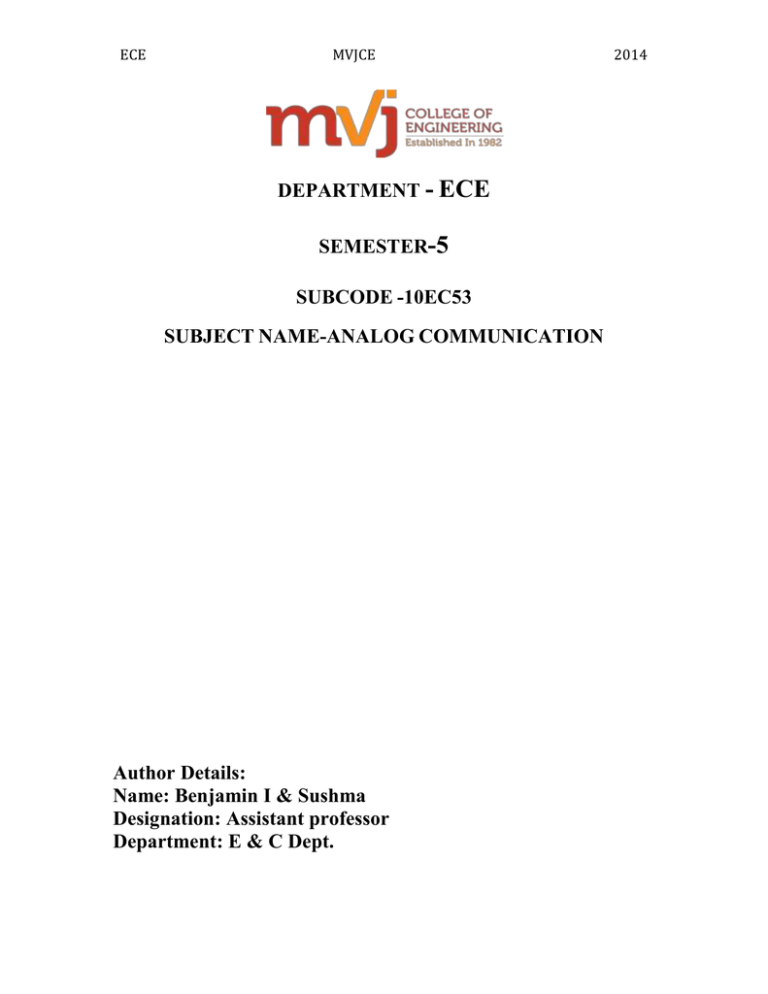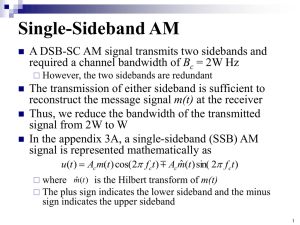ece mvjce 2014 - WordPress.com
advertisement

ECE MVJCE DEPARTMENT - ECE SEMESTER-5 SUBCODE -10EC53 SUBJECT NAME-ANALOG COMMUNICATION Author Details: Name: Benjamin I & Sushma Designation: Assistant professor Department: E & C Dept. 2014 ECE MVJCE 2014 UNIT 4 Vestigial side band Modulation Vestigial sideband is a type of Amplitude modulation in which one side band is completely passed along with trace or tail or vestige of the other side band. VSBis a compromise between SSB and DSBSC modulation. In SSB, we send only one side band, the Bandwidth required to send SSB wave is w. SSB is not appropriate way of modulation when the message signal contains significant components at extremely low frequencies. To overcome this VSB is used Frequency domain Description: Fig illustrates the spectrum of VSB modulated wave s(t) with respect to the message m(t)( bandlimited ) M(f) -w 0 w f Fig(a) Spectrum of message signal S(f) -fc-w -fc -fc+fv 0 fc-fv fc fc+w f wfvfvw Fig(b) Spectrum of VSB wave containing vestige of the Lower side band Assume that the Lower side band is modified into the vestigial side band. The ECE MVJCE 2014 vestige of the lower sideband compensates for the amount removed from the B = w+fv Where fv is the width of the vestigial side band. Similarly, if Upper side band is modified into the vestigial side band then, ANALOG COMMUNICATION [10EC53] 3 ECE MVJCE 2014 S(f) -fc-fv -fc fv -fc+w 0 fc-w fcfc+fvf wfv w Fig (d) Spectrum of VSB wave containing vestige of the Upper side band The vestige of the Upper sideband compensates for the amount removed from the Lower sideband. The bandwidth required to send VSB wave is B = w+fv Where fv is the width of the vestigial side band. Therefore, VSB has the virtue of conserving bandwidth almost as efficiently as SSB modulation, while retaining the excellent low-frequency base band characteristics of DSBSC and it is standard for the transmission of TV signals. ANALOG COMMUNICATION [10EC53] 4 ECE MVJCE 2014 Generation of VSB modulated wave: VSB modulated wave is obtained by passing DSBSC through a sideband shaping filter as shown in fig below. m(t) DSBSC s(t) Product Modulator Sideband shaping filter Accos2πfct Fig(a) Block diagram of VSB Modulator The exact design of this filter depends on the spectrum of the VSB waves. The relation b/n filter transfer function H(f) and the spectrum of VSB waves is given by S(f) = Ac /2 [M (f - fc) + M(f + fc)]H(f) ------------------------(1) Where M(f) is the spectrum of Message Signal. Now, we have to determine the Specification for the Filter transfer function H(f) It can be obtained by passing s(t) to a coherent detector and determining the necessary condition for Undistorted version of the message signal m(t). Thus,s(t) is multiplied by a Locally generated sinusoidal wave cos2πfct, which is synchronous with the carrier wave Accos2πfct in both frequency and phase, as in fig below, s(t) v(t) vo(t) Product Modulator Low Pass Filtr cos2πfct Fig(b). Block diagram of VSB Demodulator v(t) = s(t). cos2πfct------------------------------------Then, - (2) In frequency domain Eqn (2) becomes, V(f) = ½ [S( f - fc ) + S( f + fc )] --------------------------------------- (3) ANALOG COMMUNICATION [10EC53] 5 ECE MVJCE 2014 Substitution of Eqn (1) in Eqn (3) gives Fig ©. Spectrum of the product modulator output v(t) ANALOG COMMUNICATION [10EC53] 6 ECE MVJCE 2014 Pass v(t) to a Low pass filter to eliminate VSB wave corresponding to 2fc. Vo(f) = Ac /4 M(f)[H (f - fc) + H(f + fc)] ------------------------------------------- (5) The spectrum of Vo(f) is in fig below, Vo(f) Ac /4 M(0)[H (- fc) + H(fc)] -w 0 w f Fig (d). Spectrum of the demodulated Signal vo(t). For a distortion less reproduction of the original signal m(t), Vo(f) to be a scaled version of M(f). Therefore, the transfer function H(f) must satisfy the condition H (f - fc) + H(f + fc) = 2H(fc)------------------- (6) Where H(fc) is a constant Since m(t) is a band limited signal, we need to satisfy eqn (6) in the interval - w≤f≤w. The requirement of eqn (6) is satisfied by using a filter whose transfer function is shown below Fig (e) Frequency response of sideband shaping filter Note: H(f) is Shown for positive frequencies only. ANALOG COMMUNICATION [10EC53] 7 ECE MVJCE 2014 The Response is normalized so that H(f) at fc is 0.5. Inside this interval fcfv≤f≤fc+fvresponse exhibits odd symmetry. i.e., Sum of the values of H(f) at any two frequencies equally displaced above and below is Unity. Similarly, The transfer function H(f) of the filter for sending Lower sideband along with the vestige of the Upper sideband is shown in fig below, H(f) 1.0 0.5 0 fc-w fc-fvfcfc+fv f Fig (f) Frequency response of sideband shaping filter Note: H(f) is Shown for positive frequencies only. ANALOG COMMUNICATION [10EC53] 8 ECE MVJCE 2014 Time domain description: Time domain representation of VSB modulated wave, Procedure is similar to SSB Modulated waves. Let s(t) denote a VSB modulated wave and assuming that s(t) containing Upper sideband along with the Vestige of the Lower sideband. VSB modulated wave s(t) is the output from Sideband shaping filter, whose input is DSBSC wave. The filter transfer function H(f) is of the form as in fig below, H(f) 1.0 0.5 0 fc-fvfc fc+fvfc+w f Fig (1) H(f) of sideband shaping filter The DSBSC Modulated wave is SDSBSC(t) = Ac m(t) cos2πfct ---------------------- (1) It is a band pass signal and has in-phase component only. Its low pass complex envelope is given by DSBS C (t) = A m(t) c --------------------------------------(2) The VSB modulated wave is a band pass signal. Let the low pass signal (t) denote the complex envelope of VSB wave s(t), then s(t) = Re[ (t) exp(j2πfct)] ------------------------- (3) To determine (t) we proceed as follows (1) The side band shaping filter transfer function H(f) is replaced by its equivalent complex low pass transfer function denoted by (f) as shown in fig below (f) 1.0 0.5 ANALOG COMMUNICATION [10EC53] 9 ECE MVJCE 2014 Fig (2) Low pass equivalent to H(f) We may express (f) as the difference between two components (f) =(f) -(f) ------------------------------ (f) and (f) as (4) These two components are considered individually as follows i). The transfer function (f) pertains to a complex low pass filter equivalent to a band pass filter design to reject the lower side band completely as (f) 1.0 0 w f Fig (3) First component of (f) (f) = ½ [1+sgn(f)], 0<f<w 0, otherwise ----------------- (5) ii). The transfer function (f) accounts for the generation of vestige and removal of a corresponding portion from the upper side band. (f) 0.5 f -fv-0.5 fv Fig (4) Second component of (f) Substitute eqn(5) in eqn (4) we get, (f) = ½ [1+sgn(f) - 2 0, (f)], fv<f<w otherwise ----------------- (6) ANALOG COMMUNICATION [10EC53] 10 ECE MVJCE 2014 The sgn(f) and (f) are both odd functions of frequency, Hence, both they have purely imaginary Inverse Fourier Transform (FT). Accordingly, we may introduce a new transfer function HQ(f) = 1/j[sgn(f) - 2 (f)] ------------ (7) It has purely Inverse FT and hQ(t) denote IFT of HQ(f) jHQ(f) 1.0 -fv0fvf -1.0 Fig(5) Transfer function of the filter jHQ(f) Rewrite eqn(6) interms of HQ(f) as (f) = ½ [1+jHQ(f)], 0, fv<f<w otherwise ----------------(8) 2. The DSBSC modulated wave is replaced by its complex envelope as DSBSC(f) = Ac M(f) ----------------- (9) 3. The desired complex envelope (t) is determined by evaluating IFT of the product (f) DSBSC(f). i.e., (f) = (f) DSBSC(f) ------------------------ (10) (f) =Ac/2[1+jHQ(f)] M[f] -------------------------(11) Take IFT of eqn(11) we get, (t) = Ac/2[m(t) + jmQ(t)] ---------------------(12) Where mQ(t) is the response produced by passing the message through a low pass filter of impulse response hQ(t). Substitute eqn(12) in eqn(3) and simplify, we get S(t) = Ac/2 m(t) cos2πfct - Ac/2 mQ(t) sin2πfct -------------------- (13) Where Ac/2 m(t) ----- In-phase component Ac/2 mQ(t)----- Quadrature component ANALOG COMMUNICATION [10EC53] 11 ECE MVJCE 2014 Note: 1.3 If vestigial side band is increased to full side band, VSB becomes DSCSB. i.e., mQ(t) = 0 1.4 If vestigial side band is reduced to Zero, VSB becomes SSB. i.e., mQ(t) = (t) Where (t) is the Hilbert transform of m(t). Similarly If VSB containing a vestige of the Upper sideband, then s(t) is given by S(t) = Ac/2 m(t) cos2πfct + Ac/2 mQ(t) sin2πfct ANALOG COMMUNICATION [10EC53] 12




